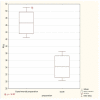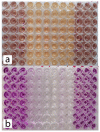Study of Cytotoxic Properties of an Experimental Preparation with Features of a Dental Infiltrant
- PMID: 34066813
- PMCID: PMC8125919
- DOI: 10.3390/ma14092442
Study of Cytotoxic Properties of an Experimental Preparation with Features of a Dental Infiltrant
Abstract
Microinvasive dentistry is based on the treatment of early carious lesions with the use of dental infiltrants. The commercially available Icon dental infiltrant does not contain any bacteriostatic component. An experimental preparation enriched with the missing component was synthesised. The aim of this study was to evaluate the cytotoxicity of the experimental preparation. Mouse fibroblasts of the L-929 lineage were used for the in vitro study. Cell morphology and viability were assessed. In the cytotoxicity analysis, it was shown that the experimental preparation (42.8 ± 10.3) after 24 h at two-fold dilution showed similar cytotoxicity to Icon (42.7 ± 8.8) (p > 0.05), while at four-fold dilution experimental preparation (46.7 ± 3.1), it was less toxic than Icon (34.2 ± 3.1) (p < 0.05). The experimental preparation has the potential to provide an alternative to the Icon commercial preparation. Further research is needed to evaluate the cytotoxicity of the experimental preparation over a longer period of time.
Keywords: antimicrobial properties; dental materials; infiltrants; metronidazole; polymers.
Conflict of interest statement
The authors declare no conflict of interest.
Figures




Similar articles
-
Assessment of the Potential Ability to Penetrate into the Hard Tissues of the Root of an Experimental Preparation with the Characteristics of a Dental Infiltratant, Enriched with an Antimicrobial Component-Preliminary Study.Materials (Basel). 2021 Sep 28;14(19):5654. doi: 10.3390/ma14195654. Materials (Basel). 2021. PMID: 34640046 Free PMC article.
-
An Insight into Enamel Resin Infiltrants with Experimental Compositions.Polymers (Basel). 2022 Dec 19;14(24):5553. doi: 10.3390/polym14245553. Polymers (Basel). 2022. PMID: 36559920 Free PMC article. Review.
-
Assessing the Penetrating Abilities of Experimental Preparation with Dental Infiltrant Features Using Optical Microscope: Preliminary Study.Adv Clin Exp Med. 2016 Sep-Oct;25(5):961-969. doi: 10.17219/acem/63007. Adv Clin Exp Med. 2016. PMID: 28028962
-
Attempt to assess the infiltration of enamel made with experimental preparation using a scanning electron microscope.Open Med (Wars). 2015 Apr 3;10(1):238-248. doi: 10.1515/med-2015-0036. eCollection 2015. Open Med (Wars). 2015. PMID: 28352701 Free PMC article.
-
[Hard dental tissue minimal-invasive preparation using contemporary polymer rotating instruments and laser].Srp Arh Celok Lek. 2014 May-Jun;142(5-6):365-70. doi: 10.2298/sarh1406365b. Srp Arh Celok Lek. 2014. PMID: 25033597 Review. Serbian.
Cited by
-
The effect of expired orthodontic bonding material on primary human gingival fibroblasts: In vitro study.J Orthod Sci. 2025 Mar 25;14:3. doi: 10.4103/jos.jos_67_24. eCollection 2025. J Orthod Sci. 2025. PMID: 40302880 Free PMC article.
-
Assessment of the Potential Ability to Penetrate into the Hard Tissues of the Root of an Experimental Preparation with the Characteristics of a Dental Infiltratant, Enriched with an Antimicrobial Component-Preliminary Study.Materials (Basel). 2021 Sep 28;14(19):5654. doi: 10.3390/ma14195654. Materials (Basel). 2021. PMID: 34640046 Free PMC article.
-
Composite and Polymeric Materials for Dentistry: Enhancing Antimicrobial and Mechanical Properties.Materials (Basel). 2023 Feb 8;16(4):1432. doi: 10.3390/ma16041432. Materials (Basel). 2023. PMID: 36837061 Free PMC article.
-
An Insight into Enamel Resin Infiltrants with Experimental Compositions.Polymers (Basel). 2022 Dec 19;14(24):5553. doi: 10.3390/polym14245553. Polymers (Basel). 2022. PMID: 36559920 Free PMC article. Review.
References
-
- Skucha-Nowak M., Skorus M., Nowak M., Tanasiewicz M. Stomatologia minimalnie inwazyjna. Twój Przegląd Stomatol. 2018;3:23–26.
-
- Skucha-Nowak M., Fischer M., Tanasiewicz M., Machorowska-Pieniążek A., Skaba D., Kielbassa A. Attempt to modify the chemical model of enamel demineralization used in microinvasive dentistry. J. Stomatol. 2019;72:17–22.
-
- Showkat N., Singh G., Singla K., Sareen K., Chowdhury C., Jindal L. Minimal Invasive Dentistry: Literature Review. J. CMRO. 2020;3:631–636. doi: 10.15520/jcmro.v3i09.340. - DOI
-
- Dawett B., Young S., Deery C., Banerjee A. Minimally Invasive Selective Caries Removal put into Practice. Dent. Update. 2020;47:10. doi: 10.12968/denu.2020.47.10.841. - DOI
Grants and funding
LinkOut - more resources
Full Text Sources

